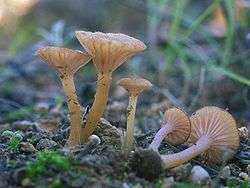Contumyces
Contumyces is a genus of brightly colored possibly bryophilous or graminicolous agarics in the Hymenochaetales. They have an omphalinoid morphology, and therefore were previously classified in Omphalina.[1][2] They inhabit mossy or grassy silty or sandy soils in the Northern Hemisphere. Phylogenetically related agarics are in the genera Rickenella, Gyroflexus, Loreleia, Cantharellopsis and Blasiphalia, as well as the stipitate-stereoid genera Muscinupta and Cotylidia[3] and clavarioid genus, Alloclavaria.[4] Contumyces is most similar to Rickenella and Blasiphalia and differs by having its cystidia on the cap, stipe, and hymenium in clusters, whereas in Rickenella and Blasiphalia the cystidia are solitary.
| Contumyces | |
|---|---|
 | |
| Contumyces rosellus | |
| Scientific classification | |
| Kingdom: | |
| Division: | |
| Class: | |
| Order: | |
| Family: | |
| Genus: | Contumyces Redhead, Moncalvo, Vilgalys & Lutzoni (2002) |
| Type species | |
| Contumyces rosellus (M.M.Moser) Redhead, Moncalvo, Vilgalys & Lutzoni (2002) | |
| species | |
|
C. brunneolilacinus | |
Etymology
Contumyces is named after the contemporary amateur Italian mycologist, Marco E. Contu (professionally an Italian criminal court judge) and is a replacement for the illegitimate generic name Jacobia, so named after Jakob Emanuel Lange by Contu,[5] but unfortunately a later homonym of Jacobea, a genus of flowering plants. The generic name was erroneously stated to be feminine[6] but is in fact masculine because of the '-myces' base.
References
- Redhead, S.A.; et al. (2002a). "Phylogeny of agarics: partial systematics solutions for bryophilous omphalinoid agarics outside of the Agaricales (euagarics)". Mycotaxon. 82: 151–168.
- Redhead, S.A.; et al. (2002b). "Phylogeny of agarics: partial systematics solutions for core omphalinoid genera in the Agaricales (euagarics)". Mycotaxon. 83: 19–57.
- Larsson, K.-H.; et al. (2006) [2007]. "Hymenochaetales: a molecular phylogeny for the hymenochaetoid clade". Mycologia. 98 (6): 926–936. doi:10.3852/mycologia.98.6.926. PMID 17486969.
- Dentinger, B.T.M.; McLaughlin, D.J. (2006). "Reconstructing the Clavariaceae using nuclear large subunit rDNA sequences and a new genus segregated from Clavaria". Mycologia. 98 (5): 746–762. doi:10.3852/mycologia.98.5.746. PMID 17256578.
- Contu M. (1997). "Jacobia, un nuovo genere di Tricholomataceae omfalinoidi". Bollettino del Gruppo Micologico "G. Bresadola" (in Italian). 40 (2–3): 169–713 (see p. 170).
- Redhead, S.A.; et al. (2002a). "Phylogeny of agarics: partial systematics solutions for bryophilous omphalinoid agarics outside of the Agaricales (euagarics)". Mycotaxon. 82: 151–168.